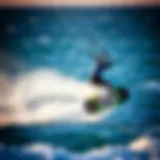Mastering E Foil Lessons: Precision on Water


Intro
As water beckons enthusiasts from all walks of life, the emergence of e foiling has turned heads in the adventure sport community. This innovative pastime combines the thrill of surfing with cutting-edge technology, enabling participants to glide effortlessly across the water's surface like a bird taking flight. But what exactly does it take to master this electrifying experience?
In this piece, we will be diving deep into the essential lessons of e foiling. It's not just about standing on a board with a foil beneath; it's about precision, technique, and understanding the equipment that enhances the adventure. The beauty of e foiling lies in its inclusiveness—whether you're just starting to dip your toes in the water or you’re an old hand looking to refine your technique, this guide has something for everyone.
Navigating through the labyrinth of gear, techniques, and tips, we'll illuminate the path to becoming a proficient e foiler, ensuring safety and performance enhancement are at the forefront of this exhilarating journey.
Equipment Insights
When embarking on the journey of e foiling, choosing the right equipment is paramount. It’s akin to setting the right foundation before building a house; without it, everything can collapse.
Latest Gear Reviews
Today’s market bursts with options; brands like Lift Foils and Fliteboard lead the charge with products boasting cutting-edge technology. Their gear’s design focuses on balancing performance with safety, letting users find their feet quickly without losing the thrill.
- Lift 3 eFoil: Known for its robust build and smooth gliding experience, it’s often recommended for novices and experienced riders alike, thanks to its adjustable mast heights and customizable battery options.
- Fliteboard Flite Lithium: This model stands out for its impressive speed and maneuverability. It combines durability with an appealing design, targeting those seeking a rapid learning curve.
Choosing gear isn't just about brand reputation, though. Factors like your weight, the conditions you'll face, and your personal preferences play a huge role in your selection.
Essential Gear Maintenance
Maintaining your e foil is not merely an option; it’s a necessity to keep your equipment performing optimally. Just like a well-oiled machine, paying attention to the details can save you time and money in the long run. Here are some vital tips:
- Regular Inspections: Check your battery, wires, and control systems before every outing, ensuring there are no damages.
- Cleaning: Rinse your gear thoroughly after each day on the water to remove salt and sand. Salt can corrode parts over time, so better safe than sorry.
- Storage: Keep your board in a dry, cool location; avoid exposing it to extreme temperatures or direct sunlight for extended periods.
Staying ahead with maintenance will not only prolong the life of your equipment but enhance your overall experience.
Technique Exploration
Mastering the art of e foiling involves acquiring a set of skills that can seem daunting to beginners but are achievable with practice. Let's break down techniques into manageable bites to help anyone get started on the right foot.
Beginner Techniques
For those just stepping into this new world, starting with base techniques will lay a solid foundation. Here are some fundamentals to concentrate on:
- Stance: Position your feet shoulder-width apart. Your weight should be distributed evenly; too far forward may cause you to nosedive, while too far back could lead to losing control.
- Lift Off: Gradually apply power to lift the board off the water. It’s crucial to maintain balance during the initial lift-off.
- Edge Control: Learning how to tilt the board will help you control direction and speed.
Advanced Maneuvers
Once you've got the basics down pat, it’s time to up your game. Advanced maneuvers involve a deeper understanding of the board's responsiveness:
- Carving: Practice changing directions seamlessly while maintaining speed.
- Jumping: This maneuver should only be attempted after mastering the basics; create momentum from a small wave before lifting off the board, timing your jump with the crest.
- Tricks: Eventually you can start incorporating tricks such as spins or flips; remember to practice over water, as falls are inevitable.
"Practice doesn’t make perfect; it makes permanent."
The journey may be filled with ups and downs, but perseverance is key. Each ride is a lesson on its own, gradually leading you towards mastery.
Embarking on this journey of e foiling with a clear understanding of equipment and techniques can turn challenges into opportunities. By prioritizing safety and continual learning, riders can navigate through the waves with confidence and style, enriching their experience on the water.
Prologue to E Foiling
Understanding E Foiling is like diving into an exciting new world where water and technology combine seamlessly. This section serves as a primer for readers seeking to grasp the essence of this electrifying sport. Grabbing a board, shedding the weight of daily life, and gliding over the water with ease – that's the promise of E Foiling. But before we can ride the waves, it's crucial to lay the groundwork for informed experiences.
E Foiling, at its core, represents a significant advancement in water sports. It empowers riders to lift above the surface using an electric hydrofoil, offering a sensation akin to flying over the water. This unique experience not only appeals to seasoned water enthusiasts but also welcomes newcomers with open arms.
The popularity of E Foiling has surged recently. Enthusiasts are drawn to the blend of thrill and serenity— the quiet hum of the electric motor and the smooth ride over the water are incomparable. It's no surprise that this sport is swiftly gaining traction in coastal communities and cities with accessible water bodies.
Key Elements:
- Versatility: Suitable for all skill levels.
- Accessibility: Technology makes it easier to learn the basics.
- Environmental Impact: Generally more eco-friendly than traditional motorized water sports.
But you're not just grabbing a board; you're also becoming part of a growing community that values the harmony between humans and nature. People engage in E Foiling not just for the rush but for social experiences, connecting through shared love for the water. The community aspect adds layers to the excitement; you’re not alone on this journey. As we dive deeper, we’ll address what E Foiling entails, how its popularity has grown, and the benefits of getting involved.
What is E Foiling?
E Foiling is an innovative watersport that combines aspects of surfing, kitesurfing, and traditional foiling, facilitated by an electric-powered lift mechanism. By standing on a board equipped with a hydrofoil and utilizing an electric motor, riders can glide above the water at varying speeds, creating a thrilling experience. It’s a fusion of sport and technology that allows for smoother rides in various water conditions.
A typical E Foil setup includes a powered board, battery pack, and remote control to manage speed and direction. This advances the elegance of gliding, where riders can experience the tranquility of nature while also harnessing the thrill speed can bring. Essentially, E Foiling allows anyone, regardless of their experience level, to ride the waters with more ease than traditional methods.
The Rise of E Foiling
In recent years, E Foiling has exploded onto the scene, evolving from a niche sport into a mainstream sensation. This rapid ascent is fueled by numerous factors that appeal to modern adventurers.
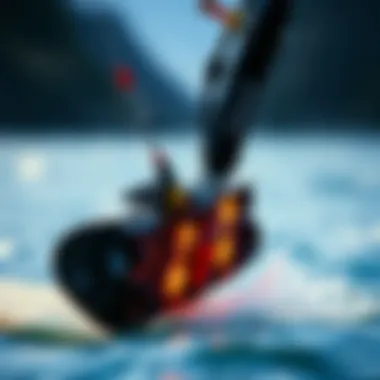
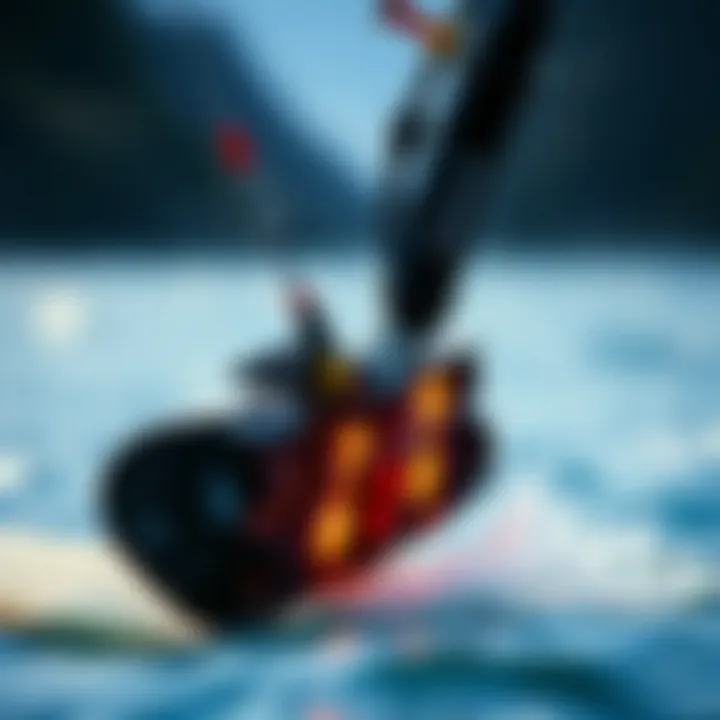
"The greatest moments in life are not the ones you spend in routine, but the ones spent breaking away from it."
As people look for novel ways to connect with the water and break free from the hustle and bustle of everyday life, E Foiling has emerged as an attractive option.
Moreover, advancements in technology have made E Foiling more affordable and accessible than ever. High-quality electric foils are hitting the market, designed for a variety of skill levels. As a result, more individuals can participate, whether at bustling beaches or serene lakes.
The role of social media cannot be overlooked either. Pictures and videos showcasing stunning rides inspire curiosity and engagement, luring newcomers and creating vibrant communities around local hotspots. Enthusiasts share tips, locations, and experiences, which further cements E Foiling's stature in the world of watersports.
As we explore this fascinating sport further, we will look at the equipment, techniques, and community that make E Foiling an unmissable experience. Stay focused, because we’re just getting started!
Technical Overview of E Foil Equipment
Understanding the technical aspects of e foil equipment is crucial for aspiring riders, as it frames the entire experience of this innovative sport. The right equipment not only enhances performance but also instills confidence while navigating the waters. When you dive into e foiling, you want to have a well-rounded comprehension of what you are dealing with. This section breaks down the vital components and principles that underlie the e foil system.
Components of an E Foil
An e foil is an intricate assembly of components that work harmoniously to create the thrilling experience of flying above the water's surface. Each piece has its role to play, whether it's the board, the hydrofoil, or the electric motor.
- Board: The heart of your ride. It’s typically made from lightweight materials like carbon fiber or fiberglass. Its design influences stability and maneuverability. Choose a board that suits your weight and skill level.
- Hydrofoil: This part is critical for lift. It consists of a mast, wings, and a stabilizer. The wings generate lift as you gain speed, allowing you to rise above the water. A well-designed hydrofoil can make a world of difference in how smoothly you glide.
- Electric Motor: Positioned on the rear, the motor provides propulsion. Different motors have varying power outputs, affecting how quickly you can take off and maintain speed. Look for a model known for reliability and sufficient performance for your intended use.
- Battery: The e foil's lifeblood. A quality lithium-ion battery can provide hours of fun, but also keeps weight in mind. Battery capacity will dictate your ride time, so factor that into your choices.
- Remote Control: A small device in your hand that lets you control speed and direction. This gadget should feel comfortable and intuitive, as your control over the board depends on it.
Together, these components form the foundation of your e foiling experience. Mastering them will not only allow you to ride better but also enhance your understanding of how they interact on the water.
Understanding Hydrodynamics in Foiling
Hydrodynamics is the study of liquids in motion, and it's immensely important when talking about e foiling. When you're cutting through the waves, the principles of hydrodynamics come into play. Understanding how water behaves around your equipment can greatly influence your performance.
- Lift Generation: As the hydrofoil moves through the water, the wings create lift due to variations in water pressure on the upper and lower surfaces. It’s this lift that allows you to ascend and glide smoothly above the surface.
- Drag Reduction: Minimizing drag is vital. The shape of your hydrofoil influences this factor. Streamlined designs create less resistance, allowing you to maintain speed with less effort.
- Speed Control: Efforts to control your speed require an understanding of how adjustments to your body position impact the hydrofoil's angle against the water. Leaning back can help with maintaining speed, while leaning forward can slow you down or help with turns.
In summary, having a grasp of the hydrodynamic principles at play lets you adapt your technique effectively. This knowledge empowers you to push your limits without compromising safety.
"In the world of e foiling, mastering your equipment and understanding the physics of movement mesh into the very essence of the joy it brings."
By recognizing these elements, you set the stage for successful and exhilarating e foiling. As you become more acquainted with the technical aspects, you'll find that these insights not only make riding more enjoyable but also enhance your overall skill level in the sport.
Preparing for Your First E Foil Lesson
Before you jump onto the e foil board, it’s crucial to lay a solid groundwork. Preparing for your first e foil lesson isn’t just about showing up; it’s about setting the stage for success. With the right equipment, the perfect location, and a sound understanding of safety protocols, beginners can transition smoother into this thrilling water sport. Each element plays a vital role, ensuring that not only is the first experience enjoyable but also safe and educational.
Selecting the Right Equipment
When it comes to e foiling, your choice of equipment can make or break your initial experience. Think of it as the difference between a sturdy ship and a leaky raft. If you’re just starting, look for an e foil setup that is user-friendly and stable.
Here are some key points to consider when choosing:
- Board Size: A larger board can offer more stability, which is helpful for beginners as it assists with balancing.
- Motor Power: Look for a motor with adjustable speed. A power setting that allows slow starts can be essential for getting a feel for the water without feeling overwhelmed.
- Battery Life: Ensure the e foil has sufficient battery life for your intended session. A session cut short can be frustrating for newbies.
- Weight Capacity: Make sure the equipment can support your weight comfortably, as this impacts performance and safety.
Opt for brands like Lift Foils or Fliteboard, which are known for their beginner-friendly models. Remember, the right gear enhances your experience and allows you to learn efficiently.
Finding the Ideal Location
Finding the right spot to learn can significantly enhance your e foiling experience. Ideally, you want a place with calm waters and minimal currents. Choppy waves and strong winds can quickly turn a fun lesson into a workout fiasco. Here are a few things to keep in mind:
- Local Beaches or Lakes: Scout local beaches or lake areas that are less busy and have vast flat spaces. Places where experienced e foilers practice are good bets, as they often know the safe zones.
- Water Temperature: Consider the time of year, as colder water may necessitate a wetsuit, affecting comfort and focus during your lesson.
- Accessibility: Choose a location that's easily reachable, with amenities such as nearby parking and easy water access. Being able to launch smoothly can keep you relaxed.
Engage with local e foiling groups or lessons to get recommendations. Often, more seasoned foilers know about secluded spots that are perfect for beginners.
Safety First: Essential Guidelines
Safety padding isn't just a cozy thought—it's a necessity that can make a world of difference. E foiling, while exhilarating, does come with its own set of risks. Here are some guidelines to ensure your safety when stepping onto the board:
- Wear a Life Jacket: It’s not optional if you’re a novice. A personal flotation device can keep you afloat if you take a tumble.
- Know Your Surroundings: Before you glide out, take a moment to understand the water conditions, including currents, wind direction, and potential hazards like buoys or rocks.
- Always Foil with Others: If possible, learn with a buddy. Having another person around can help you in case of emergencies.
- Stay Alert: Avoid distractions and keep an eye out for other watercraft. Even a moment’s lapse can lead to accidents.
"Preparedness is the key to enjoying e foiling to the fullest—after all, it’s all about harnessing the water with confidence and precision."
In summary, preparing for your first e foil lesson is about aligning your gear, choosing a flawless location, and adhering to safety guidelines. By investing time in these aspects, you’re setting the stage for what could become a lifelong passion for e foiling.
Step-by-Step Guide for E Foiling
E foiling combines aspects of surfing, kitesurfing and traditional board sports, allowing enthusiasts to hover above the water, powered by electricity. Understanding the steps involved in e foiling is crucial for anyone looking to experience this exciting activity—whether you’re a novice or an experienced water sport participant. Each step builds the foundation for succeeding in mastering the art of e foiling.
Learning to Balance on the Board
Balance is the cornerstone of e foiling. Mastering this aspect can take some time, but it pays dividends in overall performance. The balance you need to achieve transcends simply standing upright; it’s about finding your centre of gravity and understanding how the board reacts to your movements. A subtle lean forward can initiate speed, while leaning back might help in stopping or stabilizing.
To get started, follow these steps:


- Choose a stable board: Opt for a board designed for novices; these usually have wider bases for added stability.
- Position your feet: Place them shoulder-width apart over the board’s foot pads. This stance is key.
- Try floating on calm waters: Get into the water without the e foil, and practice balancing on the board to familiarize yourself.
- Utilize a tether strap: Initially, some boards come with straps to secure your feet, which can provide a safety net for beginners.
Practicing on flat, calm waters will accelerate your learning process. Few things are as frustrating as trying to learn balance amidst choppy waves.
Mastering the Take-off
The take-off is a critical transition in e foiling, where you shift from floating on the water to gracefully rising above it. Getting this right can feel like a rite of passage for new e foil riders. It involves timing, body positioning, and an understanding of how to apply pressure through the feet.
Here's how to master the take-off:
- Lean Forward: Begin by putting your weight on the front foot as you start to accelerate with the motor. This shift helps to elevate the board.
- Throttle Control: Ensure smooth and gradual acceleration. Sudden bursts of power will throw off your balance.
- Use your knees: Bending your knees can help in adjusting your centre of mass, making it easier to lift off.
"The take-off is where the magic happens. You are no longer just riding; you’re flying above the water."
Once airborne, it’s natural to feel a mix of thrill and apprehension. Your first take-off can be wobbly, but don’t let that discourage you. Persistence often breeds proficiency.
Controlling Speed and Direction
Once you’ve successfully taken off, maintaining control becomes essential. This involves managing both speed and direction with finesse. Your ability to navigate accurately through waters not only enhances your skills but also ensures safety while you ride.
To control speed and direction effectively:
- Throttle Responsiveness: Fine-tune your throttle. Gradually pressing down will help you maintain a consistent speed, which is vital for stability.
- Body Positioning: Altering your weight distribution affects how the board responds. Lean forward to accelerate, and lean back to decelerate. Side-to-side movements will help in changing direction; shifting weight towards the side you wish to turn is key.
- Anticipate Conditions: Familiarize yourself with the water currents and wind direction. These external factors play a significant role in your overall control.
For those eager to dive into e foiling, this phase of learning cannot be overstated. Just like learning to drive, the more you practice controlling your vehicle—in this case, the e foil—the more intuitive it will become.
With persistent practice and dedication, each of these steps not only builds your proficiency but also deepens your connection to this exhilarating sport.
Common Challenges in E Foiling
E foiling brings with it a unique set of challenges that every eager rider must navigate. Understanding these hurdles is fundamental not only for individual growth but also for the advancement of the sport as a whole. These challenges can range from the physical demands of maintaining balance to the technical nuances of controlling the board in unpredictable weather. By identifying and addressing these obstacles, enthusiasts can enhance their skills and enjoy a more fulfilling experience on the water.
Overcoming Balance Issues
Balance is the cornerstone of e foiling, and most riders will confront this challenge right from their first lesson. Without proper equilibrium, one risks not just lessening the thrill but also facing potential safety hazards. Even experienced kitesurfers may find that e foiling presents a different balancing act.
To achieve stability, riders should begin by focusing on their stance. A wider foot placement can distribute weight more evenly, offering a solid foundation. It’s also beneficial to keep the knees slightly bent and the body relaxed; tension can lead to overcorrection and instability.
Practicing on solid ground before taking to the waves is a prudent strategy. For instance, practicing on a stationary board can help in developing the muscle memory needed for balance. Moreover, utilizing video analysis or feedback from an instructor can provide insights that one might miss in the moment.
“Balance isn’t just about being upright; it’s about finding harmony with the water beneath you.”
Practical Tips for Balance Improvement:
- Start on calm water conditions for initial practice.
- Consistently adjust your foot placement until you find your sweet spot.
- Pay attention to your body posture; small shifts can make a world of difference.
- Engage your core muscles to maintain stability without straining.
- Reflect on each attempt, identify what worked, and what didn’t.
Navigating Through Rough Waters
The unpredictability of ocean waves can throw even seasoned e foilers for a loop. Rough waters introduce a different layer of complexity that requires strategic thinking and adaptability. When faced with choppy conditions, riders must develop a keen sense of the elements at play and adjust their riding accordingly.
A key aspect of managing rough waters is learning to read the waves. Understanding wave patterns helps riders anticipate shifts in current and avoiding wipeouts. This starts with a keen observation; spotting how waves are forming can give invaluable insights for the ride ahead.
Additionally, adopting a lower center of gravity enhances control. Leaning slightly forward can help stabilize the board as it cuts through the water instead of bouncing off the surface. Moreover, learning to use the board’s thrust and lift effectively will allow the rider to glide smoothly, even when conditions get bumpy.
Strategies for Successful Navigation in Rough Waters:
- Always keep an eye on the horizon to detect incoming waves.
- Shift your weight forward or backward depending on the wave types to maintain balance.
- Avoid panic; confidence breeds control; the calmer a rider is, the better they handle challenges.
- Practice turning and maneuvering the board quickly to avoid unexpected obstacles.
By recognizing the common challenges in e foiling and implementing effective strategies for overcoming them, riders can not only improve their own skills but also contribute to the vibrant community around this thrilling sport. This adaptability ultimately strengthens overall enjoyment and ensures that the experience remains as thrilling as it should be.
Advanced Techniques for E Foiling
As water sports continue to evolve, so do the methods used to excel within them. Advanced techniques in e foiling can be the magic ingredient that turns a leisurely outing on the water into a thrilling experience. These techniques go beyond the basics, pushing enthusiasts to polish their skills and explore the great potential this sport offers. Mastering these strategies not only enhances performance but also enriches one’s overall enjoyment and connection with the water.
Optimizing Performance and Efficiency
When it comes to e foiling, optimization is the name of the game. Getting to grips with how to balance power and finesse can be a game changer. Here are a few ways to boost performance:
- Weight Distribution: Fine-tuning your stance on the board can significantly impact how smoothly you glide over the water. Leaning your body slightly forward can help maintain stability while also reducing drag.
- Speed Control: Becoming attuned to the responsiveness of your foil can help you navigate different water conditions better. Understanding your board's speed range allows you to make quick adjustments to maintain balance, especially when taking off or cutting across waves.
- Battery Management: Efficient use of the battery ensures that your e foil has the power it needs for a longer outing. Knowing when to throttle back can conserve energy, allowing for extended rides without losing momentum.
By incorporating these tactics, riders can not only experience cleaner rides but can also adapt to varying water conditions with grace.
Tricks and Stunts to Explore
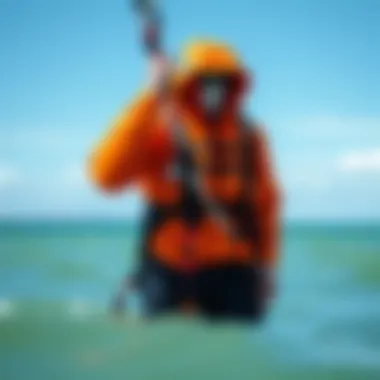
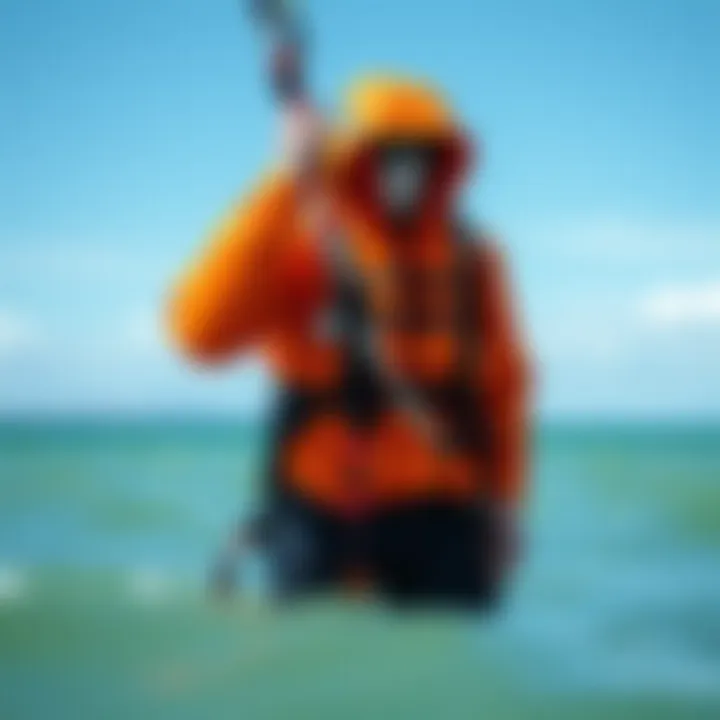
Once you’ve solidified your foundational skills, it’s time to spice things up. The sky’s the limit when it comes to stunts and tricks that can be attempted with an e foil. Here’s a selection that opens up a world of fun and excitement:
- Carving Turns: This involves shifting your weight to maneuver the board and create smooth, curvy lines on the water. Carving enhances your performance and looks visually stunning.
- Jumping: For thrill-seekers, jumping can be a breathtaking way to test skills. By using a small wave or swell, you can lift your board off the water momentarily. The key lies in timing your speed and weight shift precisely.
- 180s or 360s: Once you're feeling bold, try spinning the board in the air. A 180 requires a good amount of balance and control while you pivot mid-air. For a 360, it’s a step further, involving more speed and rotation.
- Reverse Riding: It can sound trickier than it looks, but it's about shifting your weight and steering the board backward. This is an impressive skill that can easily catch eyes on the water.
Becoming proficient in these tricks not only adds flair to your riding but also builds confidence. These advanced techniques can turn any day on the water into an exhilarating adventure.
With dedication and practice, even the most challenging tricks can become second nature, enriching your overall riding experience.
By embracing these advanced e foiling techniques, riders can significantly enhance their water experience. From mastering performance efficiency to learning daring tricks, there is always room to grow and discover new depths in this exciting sport.
For more discussions on e foiling techniques and community ideas, check resources like Reddit or explore articles on sporting advancements on sites like Britannica and Wikipedia.
Engagement with the wider e foiling community can also be found through local meet-ups and events, which foster camaraderie and exchange of tips in progressive learning.
Environmental Considerations in E Foiling
As e foiling gains traction as a thrilling water sport, it's vital to address the environmental considerations that come with it. Just like any activity that takes us closer to nature, e foiling can exert pressure on our marine ecosystems. Understanding the impact of this sport and embracing sustainable practices not only enhances our enjoyment but also ensures we maintain the delicate balance of our waterways.
Impact on Marine Life
Engaging with the water means interacting with a complex ecosystem. E foiling presents unique challenges that can affect marine life. The sound and movement of electric motors can startle wildlife, prompting them to flee from their habitats. This is particularly problematic for sensitive species such as sea turtles or nesting birds along shorelines.
A few key points to consider:
- Noise Pollution: The noise generated by e foils can disrupt aquatic animals. Fish and other marine species rely on sound for communication.
- Habitat Disruption: The movements on and off the water surface could impact the habitats of organisms living in shallow waters.
- Pollution Risks: Although electric motors reduce air pollution, battery manufacturing and disposal can introduce toxic elements into marine environments if not handled properly.
In summary, while e foiling can add excitement to our lives, it’s essential to be aware of how our actions affect the creatures we share the water with.
Sustainable Practices for E Foilers
So, how do we protect our precious waterways while enjoying e foiling? It's simpler than it sounds. By adopting sustainable practices, enthusiasts can mitigate their impact on the environment. Here are some strategies:
- Choose Eco-Friendly Equipment: Opt for e foils manufactured with sustainable materials. Some brands prioritize eco-friendly practices in their production processes.
- Practice Responsible Riding: Keep your distance from wildlife and avoid shallow areas where animals might be nesting. Respecting no-wake zones is critical.
- Participate in Clean-Up Events: Join local initiatives aimed at preserving beaches and waterways. Even the smallest effort can have a big impact on maintaining the harmony of your favorite spots.
- Educate Others: Share knowledge about the importance of caring for marine environments within the community. The more people are aware, the bigger change can happen.
In embracing these sustainable practices, not only do we become better stewards of our oceans, but we also set an example for new e foilers entering the sport. By fostering a culture of respect for nature, we can enjoy this exhilarating sport with a clear conscience.
Connecting with the E Foiling Community
Connecting with fellow E foiling enthusiasts can significantly amplify your experience in this exhilarating sport. It opens doors to shared knowledge, networking, and friendship among those who share a passion for gliding over water with electric propulsion. Engaging in the community enhances learning and helps in overcoming challenges. The growth of E foiling isn’t just about the individual; it’s about building a vibrant culture around water sports.
Local Meet-ups and Events
Participating in local meet-ups and events is a great way to forge connections with other E foilers. These gatherings can range from casual hangouts at popular water locations to organized competitions and instructional workshops. Here are some compelling reasons to get involved:
- Skill Sharing: You may learn new techniques from seasoned riders who are eager to show their tricks.
- Safety Awareness: Local events often ensure that participants are educated about best safety practices.
- Access to Resources: Meet-ups can be great times to discover new gear and tech by exchanging insights with experienced individuals.
For instance, you might find an E foiling group on Facebook or at a local beach, organizing a sundown session where both beginners and skilled riders come together. This not only helps to develop skills but also creates camaraderie that enriches the community experience.
With platforms like Meetup.com or even location-specific Facebook groups, you can easily find nearby gatherings and participate in recreational activities that fuel your passion.
Online Forums and Resources
The digital realm opened a whole new avenue for connecting with other E foilers, allowing enthusiasts to engage and exchange ideas from the comfort of their homes. Online platforms are indispensable for many modern watersport aficionados. Here are a few key resources:
- Reddit: The channel r/foiling is a bustling hub where everyone chats about gear, techniques, or arranging trips.
- Facebook Groups: Numerous groups dedicated to E foiling exist, where members share advice, tips, and plans for upcoming meet-ups.
- YouTube: With visual content leading the way, checking out tutorials and experiences shared by E foiling channels can vastly expand your knowledge.
Online discussions can lead to real-life connections, as someone might post about a planned local meet-up after exchanging ideas in the comments. Investing your time in forums not only allows for boosting your knowledge but also helps in creating lasting friendships. As you engage more, you might find exclusive online lessons or community deals on gear that can come in handy as you dive deeper into the sport.
"In sports like E foiling, building relationships within the community can be just as important as mastering the techniques on the water. Every connection enriches both your learning and your enjoyment."
Finale: The Future of E Foiling
As we plunge deeper into the realm of e foiling, the horizon looks promising for both seasoned riders and budding enthusiasts. The evolution of this sport stems not only from technological advancements but also from the growing community that embraces it. As the interest in e foiling burgeons, so too does the potential for innovation and accessibility, which are pivotal for the future of water sports.
Innovations on the Horizon
The future is brimming with possibilities. Manufacturers are constantly refining their designs, making gear lighter, and integrating smart technology into boards. One notable advancement is the emergence of adjustable hydrofoils which can cater to different skill levels and water conditions. These innovations can transform the riding experience, allowing for tailored performance that meets individual rider needs.
- Battery Efficiency: With progress in battery technology, riders can expect longer usage times and faster charge cycles. This is not just a convenience; it enhances the overall experience, making excursions on the water more enjoyable without frequent interruptions.
- Smart Controls: Boards are increasingly being equipped with app integration, allowing riders to monitor their performance metrics in real-time. This feature empowers users to tweak settings on the fly, improving learning curves and helping to track progress.
- Eco-Friendly Materials: There is a growing trend toward sustainable practices as well. Expect to see boards made from recycled materials or alternatives that minimize environmental impact, aligning with the values of many enthusiasts who care about marine ecology.
"The innovations on the rise in the e foiling industry will not only enhance personal performance but also promote a stronger connection to the environment and community."
E Foiling as a Gateway to Water Sports
E foiling holds a unique position as an entry point into the wider world of water sports. For many, being able to rise above the water can feel magical, providing a taste of freedom that leads people to explore further activities such as kiteboarding, surfing, or sailing.
- Cross-Training Opportunities: Riders can develop skills that transfer to other sports. Mastering balance on an e foil can translate well into traditional surfing, for instance. The principles of body positioning and weight distribution offer invaluable insights for other water-based activities.
- Community Integration: E foiling is becoming a social sport. Local meet-ups and online groups gather riders to share tips, experiences, and locations. This community support helps foster a culture of learning, encouraging everyone from newbies to experts to come together.
- Year-Round Engagement: With the right equipment, fans can engage year-round in various locations, breaking the seasonal limitations often associated with other sports. This heightened accessibility allows more people to get on the water and partake in the thrill of riding.
In summary, the future of e foiling is bright. Innovations promise to enhance the experience while simultaneously inviting a broader audience into the exhilarating world of water sports. Riders aren't just jetting across waves; they are partaking in a movement that champions environmental consciousness, community, and the joy of mastering something truly unique.




